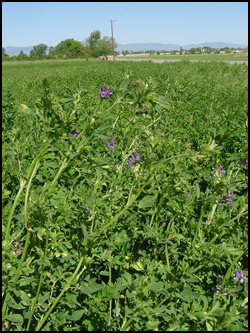Evaluate Your Stand
 Assess spring alfalfa stands and manage winter-injured stands.
Assess spring alfalfa stands and manage winter-injured stands.
The most important question alfalfa growers deal with each year is whether an alfalfa stand is good enough to keep for one more year. While this process is best done in the fall, it often ends up being put off until spring. The key springtime evaluation process is to walk fields thoroughly to determine the extent of winter kill and winter injury.
The following are tips on assessing alfalfa stands and the extent of damage to the crop. Remember to always wait until the plant is growing to do an assessment of the stand. You'll need the following few tools: a tile spade or shovel, a sharp knife, an alfalfa square and a notepad.
At first glance
When walking through the field, form a general impression of what is seen. Are the plants sending out new shoots? Are shoots just in parts of the field? With the spade, excavate several alfalfa plants and try to get at least 6 inches of root tissue. Clean soil from the root, look for any visible damage.
- Normal roots should be creamy white to tannish brown with very few scars or lesions.
- Moderate to slight damage is harder to assess but is usually manifested by slight discoloration (yellowing), a corky feel and very slow or no regrowth occurring after the soil has warmed up.
- Severely damaged roots will be discolored and possibly have a water-soaked or mushy feel to the crown region.
"It's important to walk the entire field and really survey the stands," said Mike Weiss, Syngenta Seeds Inc. field agronomist. "Many times we'll see cases where growers only sample a section of the field. Even if the field only has slight variations throughout, it's best to get a broad-spectrum assessment to ensure you have good stands for the coming growing year."
Count only healthy plants that will survive
Healthy plants are vigorously growing with firm roots and crowns. Winter-killed plants that have soft crowns and roots with little or no top growth should not be counted. They should easily pull out of the ground because roots are dead and decaying. Winter-injured plants are those not aggressively growing and with a limited number of stems per plant. Plants with only one to three stems growing out of one side of the plant should not be counted as they will likely not live through the season and will not be productive if they do live. Plants that show uneven growth but have several growing stems can be counted as they have a good chance of surviving and being productive.
As stands get older, fewer plants are required for good production. Plants in older stands normally have more highly developed crowns with more stems per crown. Use the guidelines in the chart here to assess plant density based on plants per crown and the age of the alfalfa stand:
Age of Stand (Years) |
Plant density (healthy plants per sq. ft.) | ||
Poor |
Marginal |
Good |
|
| 1 | <10 | 10-15 | 15+ |
| 2 | <8 | 8-10 | 10+ |
| 3 | <6 | 6-8 | 8+ |
| 4+ | <4 | 4-5 | 5+ |
When a stand rates poor or marginal based on plant density
If a stand rates poor or marginal, assess the stem counts per square foot (sq. ft.) that were taken when doing stand counts.
- If plant density was marginal, but there are still greater than 55 growing stems per square foot sq. ft., the stand will probably not limit yield in the current year. However, plan to replace the field soon.
- If plant density was marginal or poor, but stem density is 40 to 55 per sq. ft., there will be some yield production decrease but the field can be kept if new fields cannot be established.
- If stem density is less than 40, production will be well below average, and new alfalfa acres should be established for the coming season. These fields should be taken out of production immediately or after first cutting to maximize the value of the acres.
"While it may be tempting to keep a field with poor stem density, it really doesn't pay off in the long run," said Weiss. "By establishing a new stand, the grower can increase production and help ensure a stronger forage crop for the upcoming season."
Managing stands with marginal winter injury
If winter injured stands must be kept to meet feed needs for the coming season, it is important to minimize the amount of additional stress on these weakened plants. The following may increase the productivity of these stands:
- Delay first cutting until at least first flower. This will help the injured plants to recover, accumulate carbohydrates and heal damaged tissues. Cutting early puts additional stress on winter-injured plants and they may not recover.
- Top-dress with potash and/or phosphorus according to soil test, especially if nothing was applied last fall. Low fertility will stress these plants even more, and a little fertilizer will go a long way in optimizing production from a weakened stand.
- Do not treat with spring herbicides that are known to stunt or stress plants. The added stress of certain herbicides may take out even more plants.











